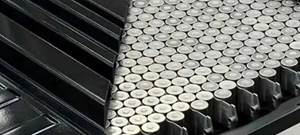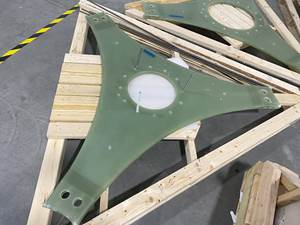BNSF Logistics and TTS cut wind blade transport costs
BNSF's Blade Runner service uses a single universal fixture for ocean, rail, truck and storage improving clearance, load factors and efficiency while TTS uses high density fixture to pack 42 blades per train.
BNSF Logistics (Flower Mound, TX, US) announced the successful testing of its innovative new fixtures developed to move wind turbine blades more efficiently. The Blade Runner service is a universal fixture designed for rail and ocean transport to optimize movement of wind components between any two points in the world. With the ratio of logistics costs for Wind projects running at nearly 2X other industries, and with strong interest from manufacturers, developers and OEMs seeking options for handling increasingly longer blades, BNSF Logistics teamed up with Energo (Houston, TX US), an engineering and design company with a long history in the Wind sector. Together, they have developed transport fixtures that will greatly increase efficiency and drive down logistics costs. The developed fixtures (patent pending) and handling solutions will benefit customers for both international and U.S. domestic moves.
Using the same technology for ocean, rail, truck and storage will allow blades to move without the need for attached fixtures, which have historically been both expensive and difficult to manage. "The Wind Energy sector has depended on decade-old methods that are increasingly irrelevant as global sourcing and the size of blades increase,” says Ray Greer, BNSF Logistics’ president. “Our universal fixtures for both ship and rail transport modernizes the wind logistics industry and will unshackle current logistics constraints facing the industry, getting the wind industry closer to that critical self-sustaining cost level.”
The universal rail fixtures are designed to handle blades of all sizes including increasingly longer blades inside the clearance windows required, making rail a viable option versus truck. This is a critical development as truck capacity is projected to be a real challenge as wind projects accelerate in 2015 and beyond. Multiple rail tests were conducted on blades over 45m in length at the Port of Corpus Christi, TX, US. The results showed a 35% improvement of clearance envelope making rail a viable mode choice for almost any North American destination.
After successful testing of the new ocean blade stowage design, BNSF Logistics estimates stowage rates to increase by a minimum of 25% over existing configurations. Additional efficiencies and direct cost reductions have been validated and details shared with potential customers under confidentiality agreements.
Industry feedback has been extremely positive. John Billingsley, CEO of Tri Global Energy, says, “Reducing all-in project building costs is an essential goal in the highly competitive electric utility power generation industry. Reducing logistics costs in our wind energy projects by using BNSF Logistics’ new shipping solutions will have a very meaningful impact on achieving that goal.”
Use of the new fixture designs is expected to begin in the second quarter of 2015 and will ramp up as quickly as manufacturing of the fixtures will allow. The impact on costs and efficiency will be realized immediately and could make previously unattractive areas more viable for wind project development.
Meanwhile, Transportation Technology Services (Southlake, TX, US) has developed its HD (High Density) Universal Blade Train fixture and configuration allows customers to ship 48 blades of 50m length on a single 72 car unit train. The newly designed stacking tip stand on the HD Universal blade train resulted in a 33% load increase over previously used loading methods reducing shipping costs. The first two HD Universal blade trains successfully delivered blades from Corpus Christi, TX to a wind farm in Kansas in the fall of 2014. Currently, there are two of these trains moving, and there are plan to additional ones in 2015.
Related Content
Composites end markets: Batteries and fuel cells (2024)
As the number of battery and fuel cell electric vehicles (EVs) grows, so do the opportunities for composites in battery enclosures and components for fuel cells.
Read MoreCeramic matrix composites: Faster, cheaper, higher temperature
New players proliferate, increasing CMC materials and manufacturing capacity, novel processes and automation to meet demand for higher part volumes and performance.
Read MoreWe4Ce infused 2.5-3-MW rotor blade design passes validation test
Composite rotor blade structure design by We4Ce, mold and prototype production by InDutch Composites and fatigue testing by Suzlon Group has resulted in the novel blade’s IEC61400-5:2020 certification.
Read MoreRTM, dry braided fabric enable faster, cost-effective manufacture for hydrokinetic turbine components
Switching from prepreg to RTM led to significant time and cost savings for the manufacture of fiberglass struts and complex carbon fiber composite foils that power ORPC’s RivGen systems.
Read MoreRead Next
Ultrasonic welding for in-space manufacturing of CFRTP
Agile Ultrasonics and NASA trial robotic-compatible carbon fiber-reinforced thermoplastic ultrasonic welding technology for space structures.
Read MoreCutting 100 pounds, certification time for the X-59 nose cone
Swift Engineering used HyperX software to remove 100 pounds from 38-foot graphite/epoxy cored nose cone for X-59 supersonic aircraft.
Read MoreScaling up, optimizing the flax fiber composite camper
Greenlander’s Sherpa RV cab, which is largely constructed from flax fiber/bio-epoxy sandwich panels, nears commercial production readiness and next-generation scale-up.
Read More











